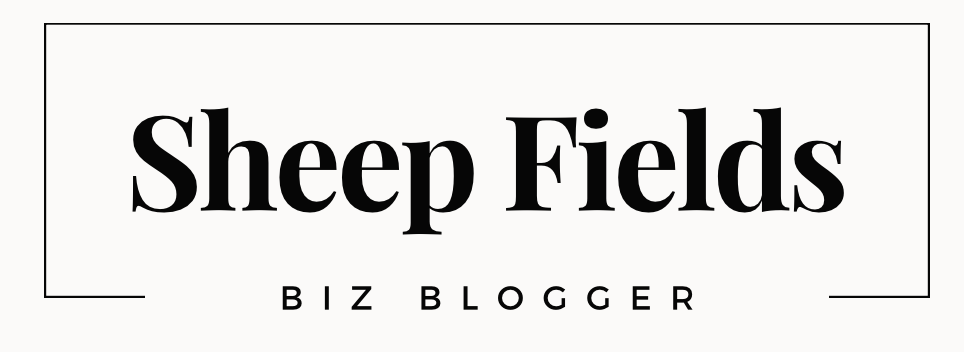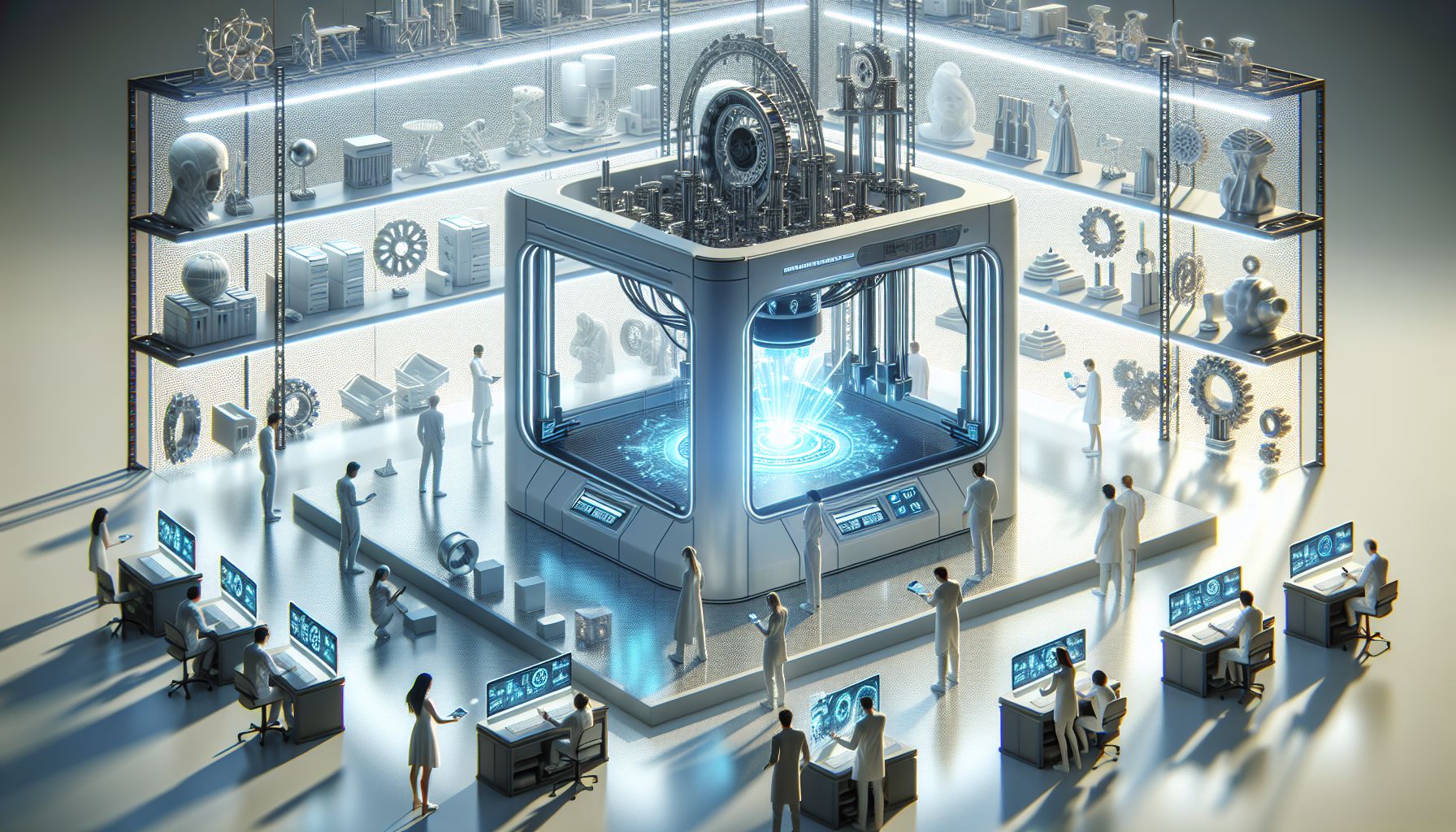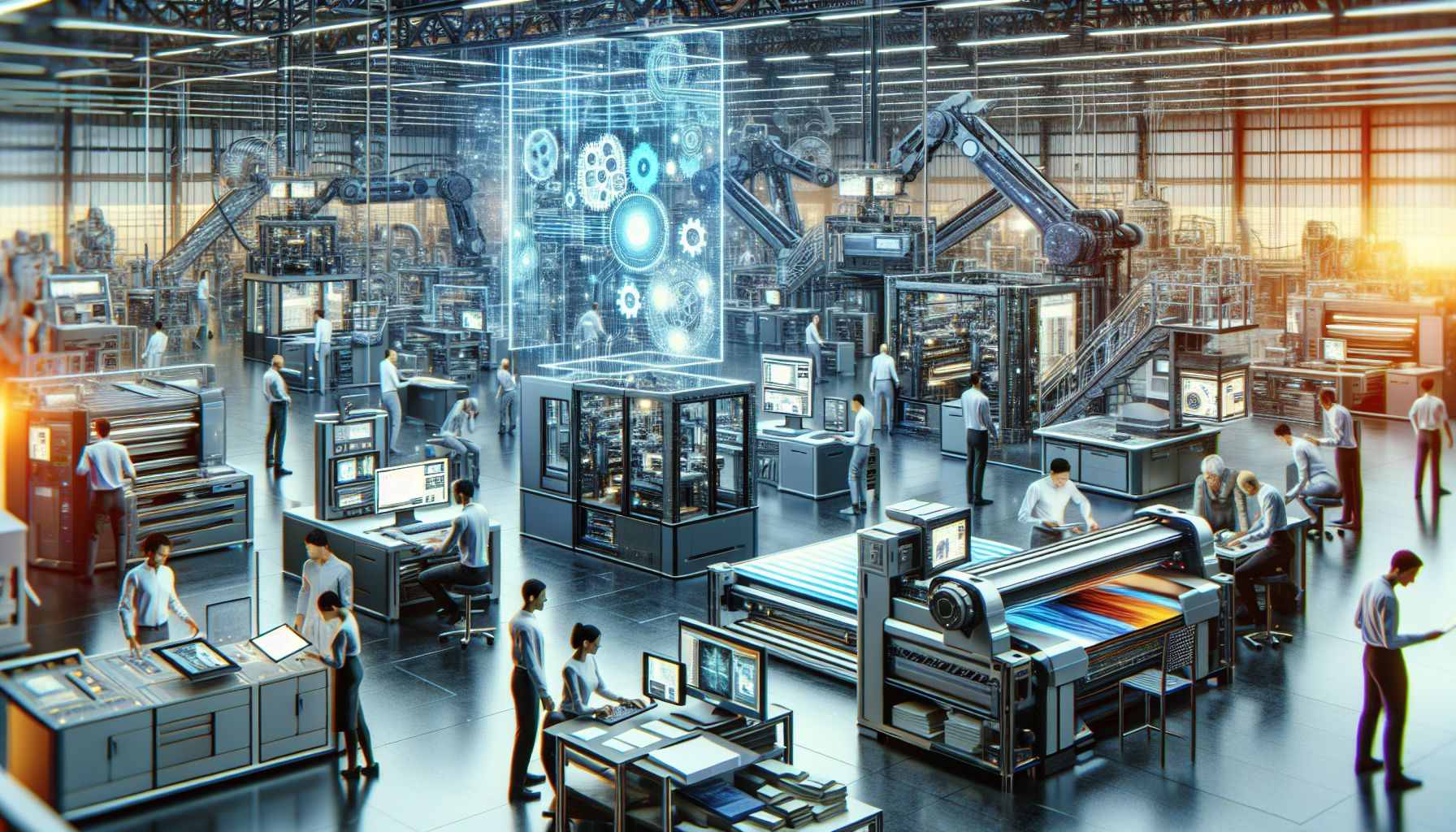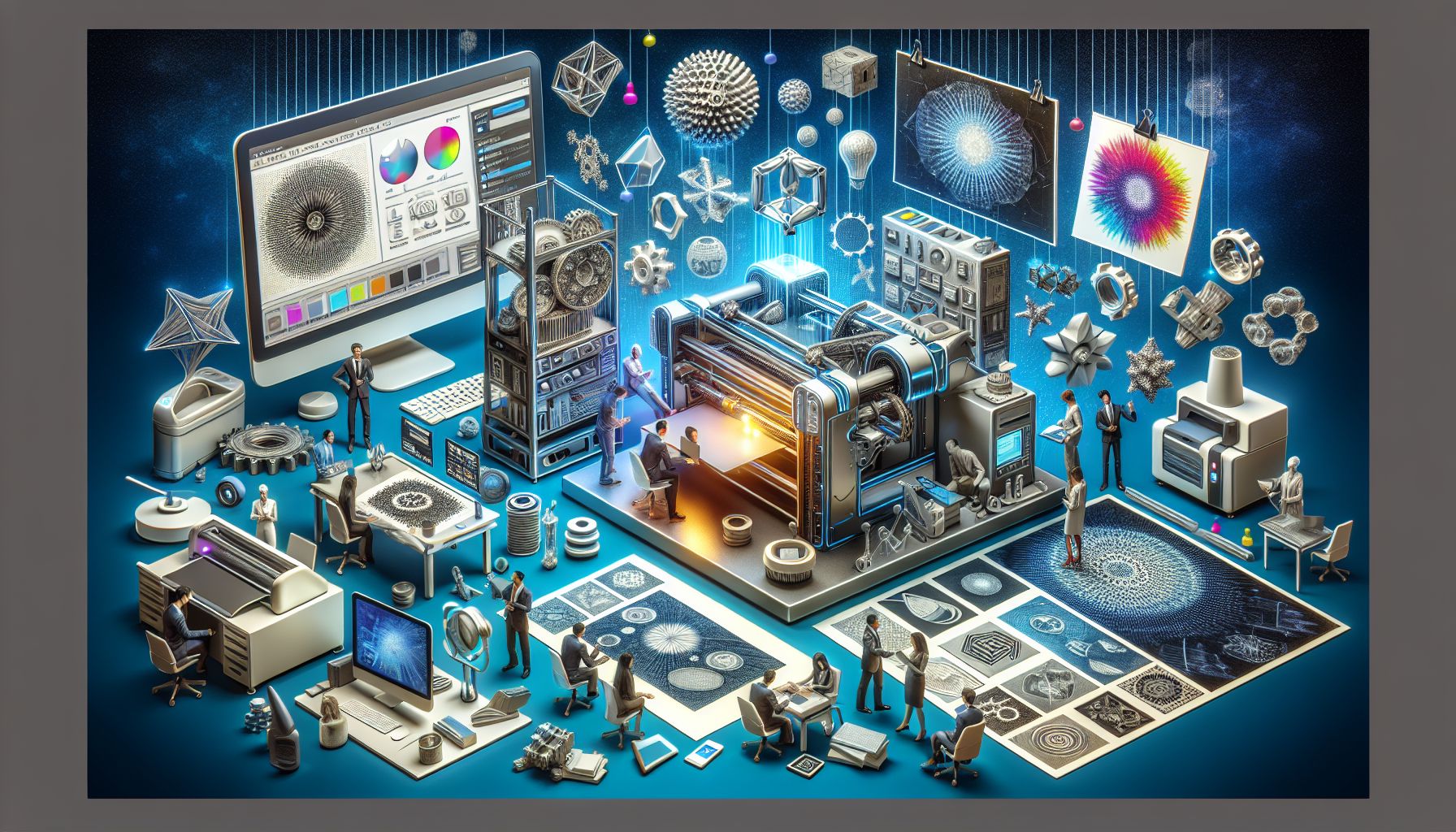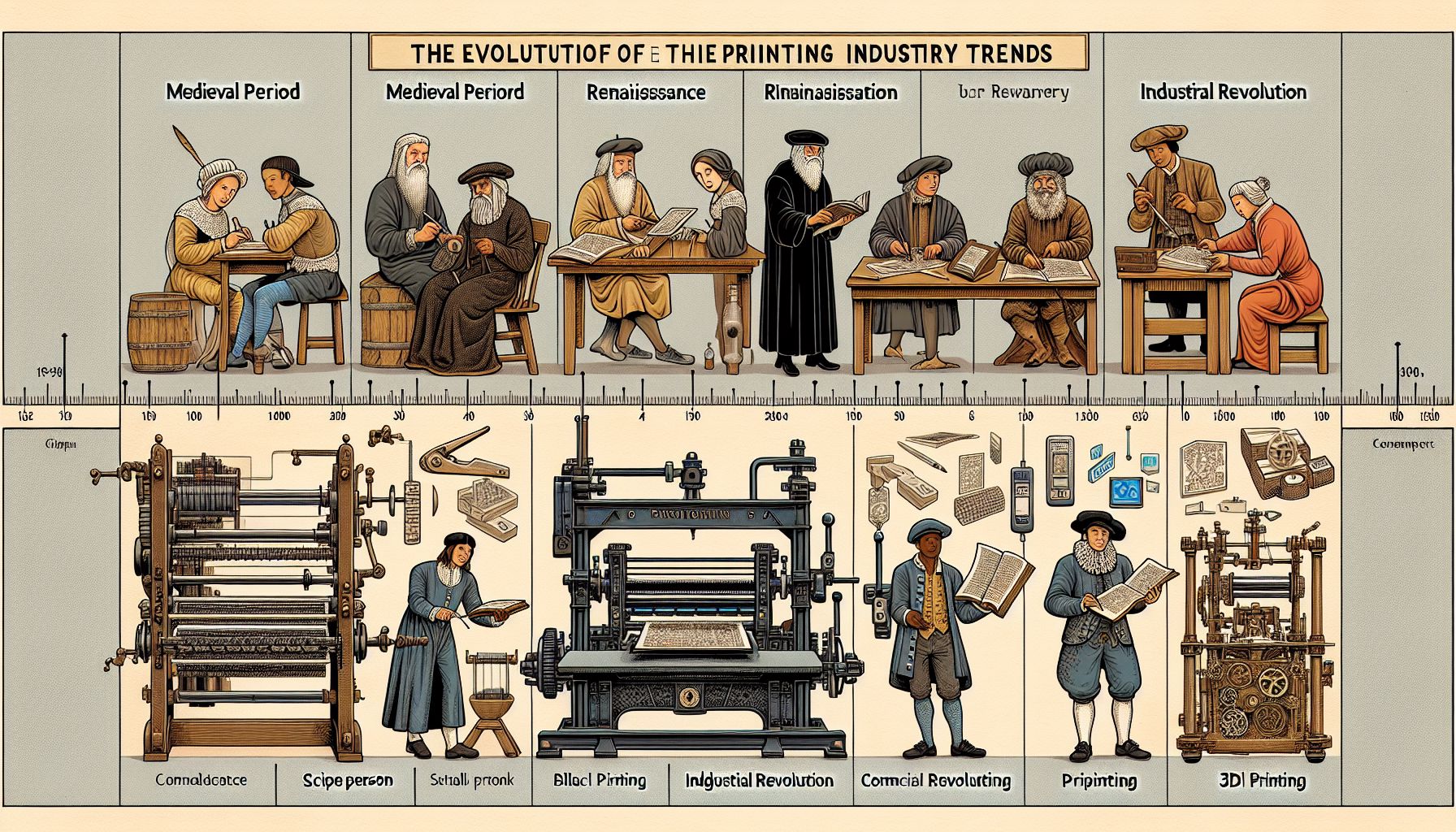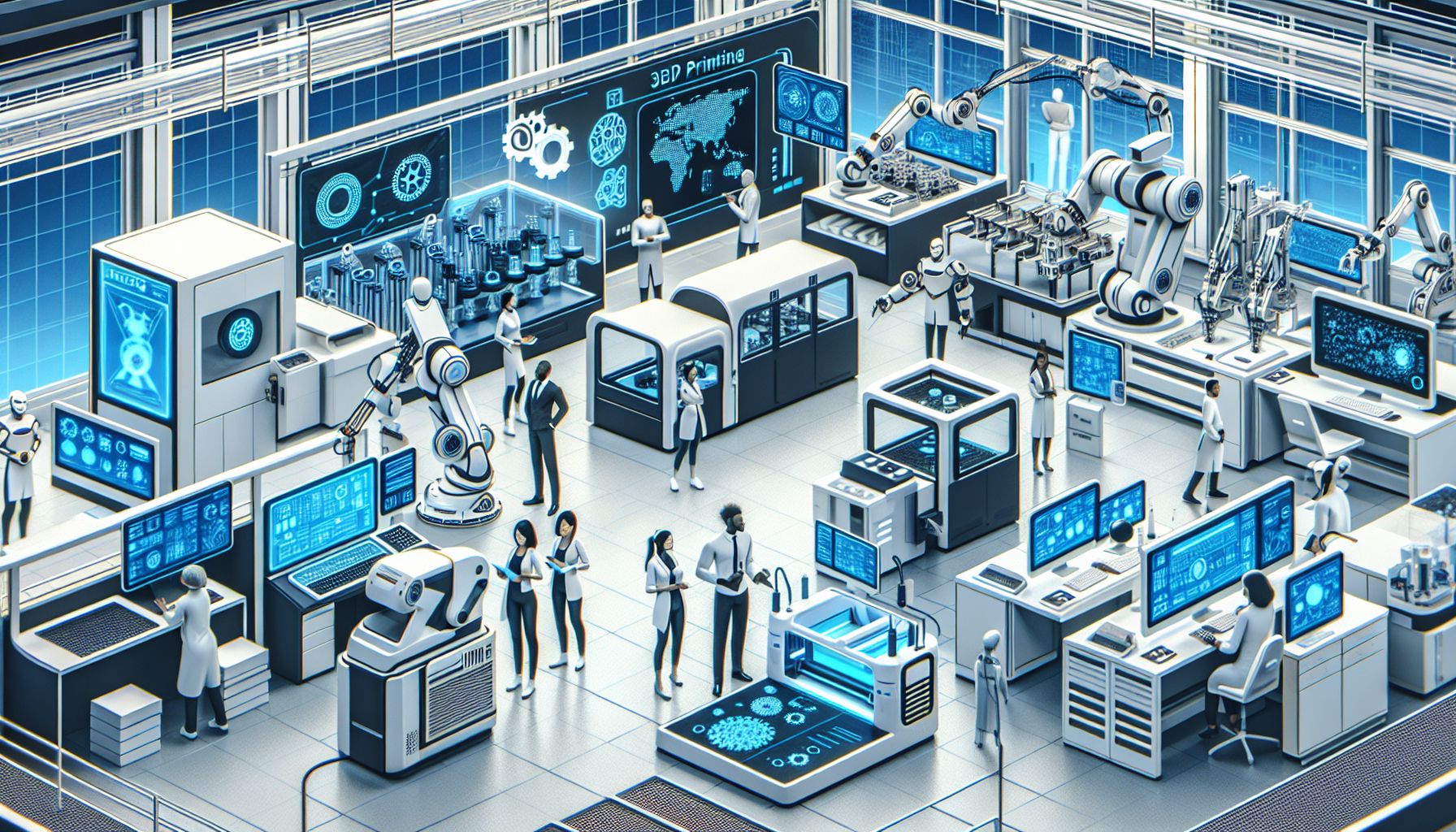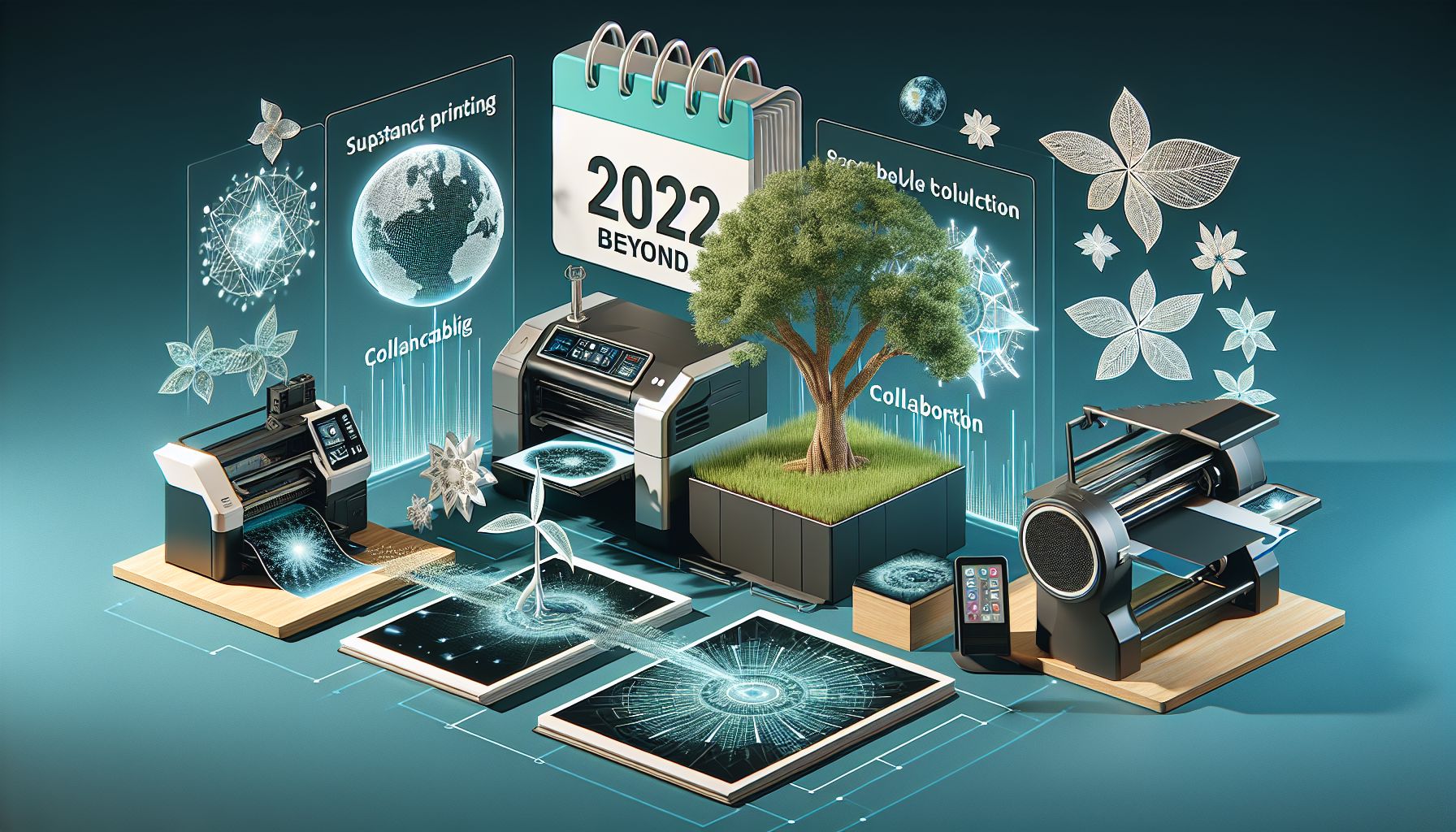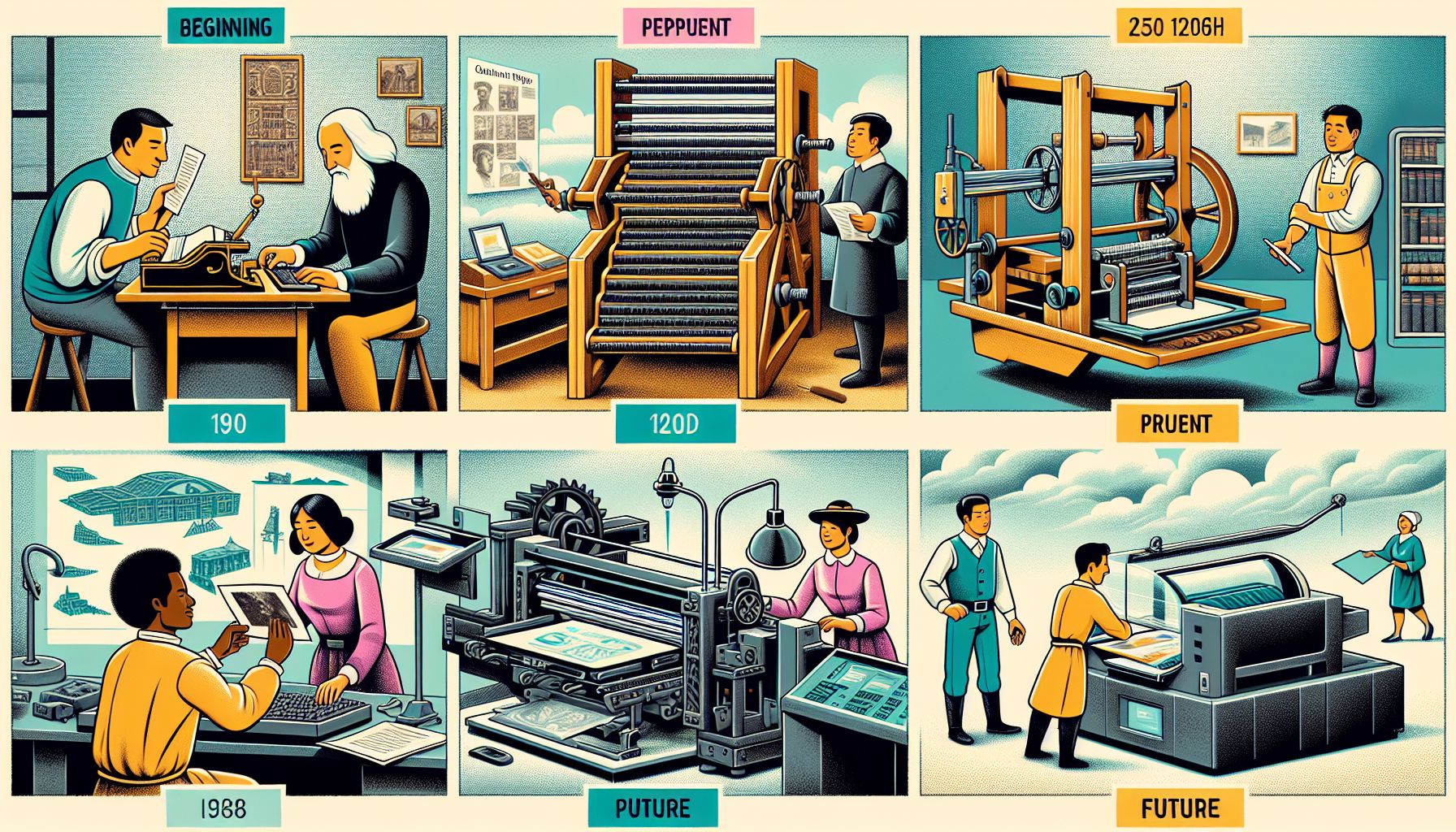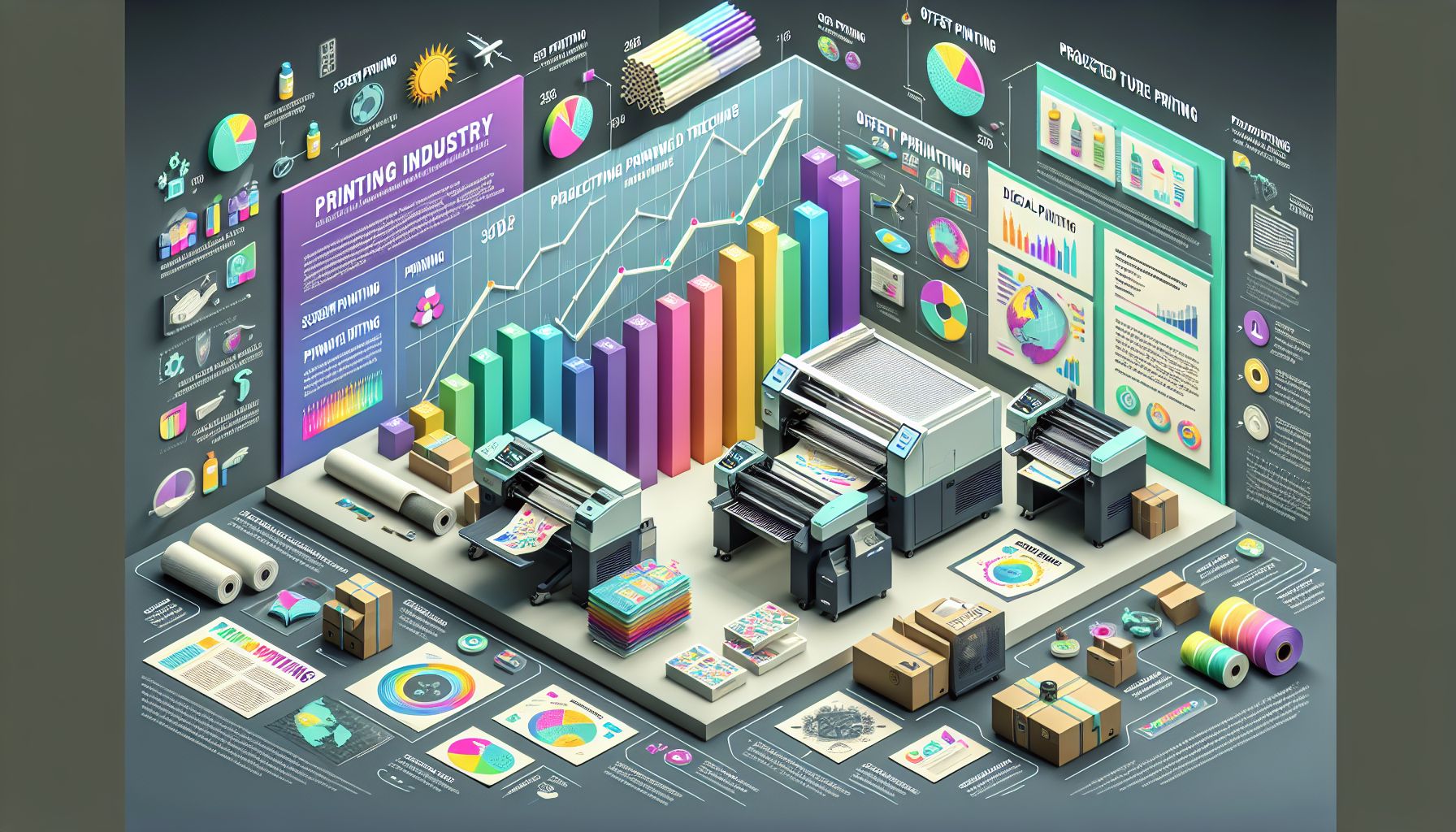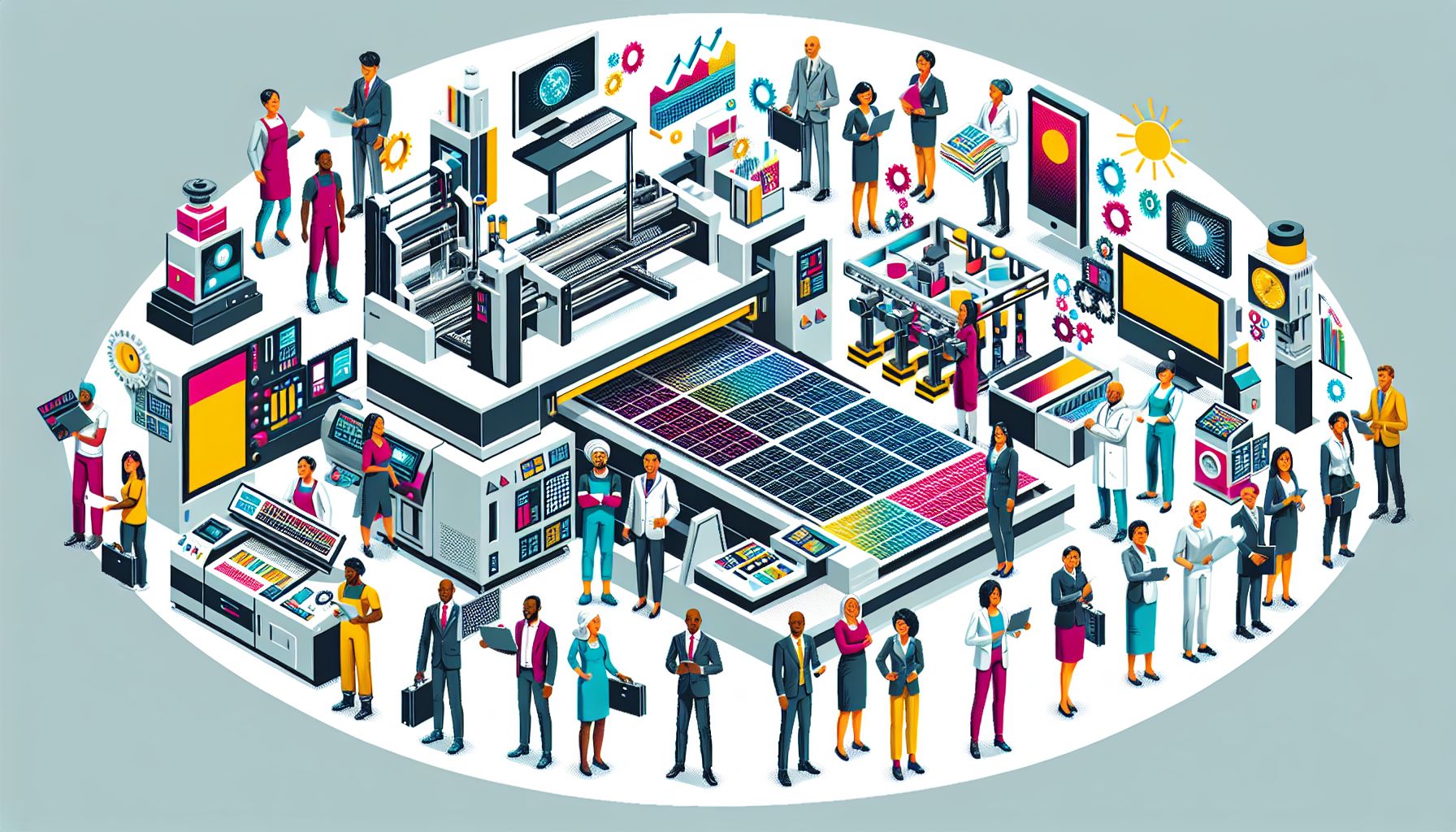The Future of Printing: Industry Trends to Watch
The printing industry has been going through significant changes in recent years, driven by technological advancements, changing consumer preferences, and global market trends. As we move further into the digital age, it’s important for businesses in the printing industry to stay ahead of the curve and adapt to these evolving trends to remain competitive and relevant in the market. In this article, we will explore some of the key trends shaping the future of the printing industry and how businesses can prepare for these changes.
Digital Transformation
One of the most prominent trends in the printing industry is the shift towards digital printing technologies. Digital printing offers several advantages over traditional offset printing, including faster turnaround times, lower costs for short print runs, and the ability to personalize content. As a result, more and more businesses are investing in digital printing equipment to meet the growing demand for customized and on-demand printing solutions.
Additionally, advancements in digital printing technology, such as high-speed inkjet printers and UV printers, have made it possible to print on a wider range of substrates and achieve higher print quality than ever before. This has opened up new opportunities for businesses in industries such as packaging, textiles, and signage to offer innovative and creative printing solutions to their customers.
Sustainability and Eco-Friendly Printing
Another important trend in the printing industry is the growing emphasis on sustainability and eco-friendly printing practices. Consumers are becoming increasingly conscious of the environmental impact of their purchasing decisions, leading businesses to prioritize sustainable printing solutions to reduce waste and carbon emissions.
In response to this trend, many printing companies are adopting eco-friendly practices such as using recycled paper, vegetable-based inks, and energy-efficient printing equipment. Additionally, some companies are investing in carbon offset programs to offset the environmental impact of their printing operations. By embracing sustainable printing practices, businesses can not only reduce their environmental footprint but also appeal to eco-conscious consumers and gain a competitive edge in the market.
3D Printing and Additive Manufacturing
3D printing, also known as additive manufacturing, is another trend that is revolutionizing the printing industry. 3D printing technology allows businesses to create three-dimensional objects layer by layer, offering endless possibilities for innovation and customization. From prototyping and product development to custom manufacturing and on-demand production, 3D printing has the potential to disrupt traditional manufacturing processes and create new business opportunities.
In recent years, advancements in 3D printing technology have made it more accessible and affordable for businesses of all sizes. As a result, we are seeing a growing number of companies incorporating 3D printing into their operations to streamline production processes, reduce costs, and offer unique products and services to their customers. With the continued development of 3D printing technologies, we can expect to see even greater adoption of this innovative printing method across a wide range of industries.
Industry Consolidation and Mergers
As the printing industry undergoes rapid evolution, we are seeing a trend towards industry consolidation and mergers. Many printing companies are joining forces to pool resources, expand their market reach, and stay competitive in an increasingly crowded market. By merging with or acquiring other companies, businesses in the printing industry can benefit from economies of scale, access new technologies and capabilities, and diversify their product offerings to meet the changing needs of their customers.
Industry consolidation also allows printing companies to streamline operations, reduce overhead costs, and improve efficiency, ultimately leading to higher profitability and sustainability in the long run. As the printing industry continues to evolve, we can expect to see more mergers and acquisitions as businesses seek to solidify their position in the market and capitalize on new growth opportunities.
Conclusion
The printing industry is undergoing significant transformation driven by technological advancements, changing consumer preferences, and global market trends. Businesses in the printing industry must stay ahead of these evolving trends to remain competitive and relevant in the market. By embracing digital printing technologies, prioritizing sustainability and eco-friendly practices, harnessing the power of 3D printing and additive manufacturing, and exploring opportunities for industry consolidation and mergers, printing companies can position themselves for success in the future.
As we look to the future of printing, it’s clear that the industry is ripe with opportunities for innovation, growth, and adaptation. By staying informed about the latest trends and technologies shaping the printing industry, businesses can position themselves as industry leaders and pioneers, driving growth and success in an ever-changing market landscape. The future of printing is bright, and by embracing these trends, businesses can unlock new possibilities and create new value for their customers and stakeholders.
The Emerging Trends in the Printing Industry
As technology continues to advance at an exponential rate, the printing industry is not exempt from the rapid changes that come along with it. From digital printing to sustainable practices, the printing industry has seen many shifts in recent years. In this article, we will explore some of the emerging trends in the printing industry and how they are shaping the future of this ever-evolving field.
Introduction of Digital Printing
Digital printing has become increasingly popular in the printing industry due to its flexibility and efficiency. Unlike traditional printing methods, digital printing allows for shorter print runs, faster turnaround times, and customizable designs. This shift in technology has made it easier for businesses to create personalized marketing materials and reduce waste by only printing what is needed.
One of the key advantages of digital printing is its ability to produce high-quality prints at a lower cost compared to traditional printing methods. This has made it a preferred choice for many businesses looking to save on printing expenses without compromising on quality. Additionally, digital printing allows for variable data printing, which enables businesses to create targeted marketing materials tailored to individual customers.
Sustainable Printing Practices
In recent years, there has been a growing emphasis on sustainable practices within the printing industry. With the rise of environmental awareness, many printing companies are implementing eco-friendly initiatives to reduce their carbon footprint. This includes using recycled paper, soy-based inks, and energy-efficient printing equipment.
Some printing companies have also invested in carbon offset programs to neutralize the environmental impact of their printing operations. By embracing sustainable printing practices, these companies are not only reducing their environmental footprint but also appealing to environmentally conscious consumers who seek eco-friendly products and services.
3D Printing Revolution
One of the most exciting trends in the printing industry is the adoption of 3D printing technology. 3D printing allows for the creation of three-dimensional objects layer by layer, making it ideal for prototyping, manufacturing, and customization. This technology has opened up new possibilities for businesses across various industries, from healthcare to automotive.
In the healthcare sector, 3D printing is being used to create medical devices, prosthetics, and even artificial organs. This technology has revolutionized the way medical professionals approach patient care, offering personalized solutions that were once thought to be impossible. In the automotive industry, 3D printing is used to create prototypes and spare parts, resulting in faster production times and cost savings.
Rise of Print-on-Demand Services
Print-on-demand services have become increasingly popular in the printing industry, allowing businesses to print products only as they are ordered. This eliminates the need for large print runs and excess inventory, ultimately reducing waste and lowering costs. Print-on-demand services are commonly used for printing books, apparel, and promotional items.
By utilizing print-on-demand services, businesses can offer a wider range of products without the risk of overproduction. This flexible and cost-effective approach to printing has enabled businesses to respond quickly to changing market demands and customer preferences. As e-commerce continues to grow, print-on-demand services are expected to become even more prevalent in the printing industry.
Augmented Reality Integration
Another emerging trend in the printing industry is the integration of augmented reality (AR) technology. By combining print media with digital content, businesses can create interactive and engaging experiences for their customers. This technology allows for the seamless integration of print and digital marketing strategies, making printed materials more interactive and memorable.
With AR integration, businesses can create dynamic print advertisements, packaging, and promotional materials that come to life when viewed through a smartphone or tablet. This not only enhances the overall customer experience but also provides valuable data on customer engagement and behavior. As AR technology continues to evolve, we can expect to see more businesses leveraging this innovative approach to printing.
Conclusion
The printing industry is constantly evolving, driven by technological advancements, changing consumer preferences, and environmental considerations. From digital printing to sustainable practices, 3D printing, print-on-demand services, and AR integration, there are many exciting trends shaping the future of the printing industry. By staying informed and adapting to these trends, businesses can remain competitive in an ever-changing marketplace and continue to provide innovative printing solutions for their customers.
The Future of Printing: Industry Trends to Watch
In today’s rapidly evolving digital landscape, the printing industry is experiencing significant changes and advancements. From technological innovations to shifting consumer behaviors, there are several key trends shaping the future of printing. In this article, we will explore some of the most important industry trends to watch in the coming years.
Introduction
The printing industry has come a long way since its inception centuries ago. With the advent of digital printing, the industry has witnessed a major transformation in recent years. The traditional concept of printing has been redefined, with new technologies and processes revolutionizing how we print and consume printed materials.
As we move further into the digital age, it is important for printing companies to stay ahead of the curve and adapt to the latest trends in the industry. By understanding and embracing these trends, printing businesses can remain competitive and continue to thrive in the ever-changing marketplace.
Industry Trends to Watch
1. Digital Printing
Digital printing has become increasingly popular in recent years due to its cost-effectiveness, flexibility, and speed. Unlike traditional offset printing, digital printing does not require plates, making it quicker and more efficient for short print runs. With advancements in digital printing technology, such as high-resolution printing and variable data printing, businesses can now produce high-quality, personalized materials at a fraction of the cost.
2. Sustainability
With growing awareness of environmental issues, consumers are demanding more sustainable and eco-friendly printing solutions. Printing companies are responding to this trend by investing in eco-friendly materials, energy-efficient equipment, and recycling programs. By prioritizing sustainability, printing businesses can attract environmentally conscious customers and reduce their impact on the planet.
3. 3D Printing
3D printing is a game-changer for the printing industry, allowing businesses to create physical objects layer by layer from digital designs. This technology is revolutionizing manufacturing processes, prototyping, and product development. As 3D printing continues to advance, we can expect to see more innovative applications in various industries, from healthcare to automotive.
4. Personalization
Consumers today expect personalized experiences in every aspect of their lives, including printed materials. Personalization in printing involves tailoring content, images, and designs to individual preferences and demographics. This trend is driving higher engagement and response rates for businesses, as personalized materials are more likely to resonate with customers and stand out in a crowded marketplace.
5. Augmented Reality
Augmented reality (AR) is another trend that is gaining traction in the printing industry. By integrating AR technology into printed materials, businesses can provide interactive and immersive experiences for their customers. AR-enhanced print materials can engage users with multimedia content, animations, and 3D models, creating a unique and memorable experience.
6. On-Demand Printing
On-demand printing is a trend that is reshaping the printing industry, allowing businesses to produce materials as needed, reducing waste and storage costs. With on-demand printing, companies can print small quantities of materials quickly and affordably, eliminating the need for large print runs and excess inventory. This trend is particularly beneficial for businesses with variable and unpredictable printing needs.
Conclusion
The printing industry is in a state of constant evolution, driven by technological advancements, changing consumer preferences, and environmental concerns. By staying informed and adapting to the latest trends, printing businesses can position themselves for success in the future. Whether it’s embracing digital printing, prioritizing sustainability, or exploring new technologies like 3D printing and augmented reality, there are numerous opportunities for growth and innovation in the printing industry.
As we look ahead to the future of printing, it is clear that the industry will continue to transform and expand in exciting ways. By keeping a pulse on emerging trends and investing in cutting-edge technologies, printing companies can stay ahead of the curve and deliver exceptional print solutions for their customers. The future of printing is bright, and the possibilities are endless.
Emerging Trends in the Printing Industry
The printing industry has evolved significantly over the past few decades, with new technologies and innovations constantly shaping the way we create and distribute printed materials. As we move into a new era of digital transformation, it’s important for professionals in the printing industry to stay ahead of the curve and adapt to emerging trends in order to remain competitive in the market.
In this blog post, we will explore some of the key trends that are currently shaping the printing industry, and discuss how businesses can leverage these trends to drive growth and success.
Digital Printing
One of the most significant trends in the printing industry is the growing popularity of digital printing. Digital printing offers a number of advantages over traditional printing methods, including shorter lead times, lower costs, and the ability to produce smaller print runs. In addition, digital printing enables businesses to personalize and customize printed materials, making it an attractive option for marketing and branding purposes.
As technology continues to advance, we can expect to see further innovations in digital printing, such as improved print quality, faster printing speeds, and the development of new materials and finishes. Businesses that are able to harness the power of digital printing will be well positioned to capitalize on this trend and differentiate themselves in the market.
Sustainability
Another key trend in the printing industry is the growing emphasis on sustainability. As consumers become more conscious of their environmental impact, businesses are under increasing pressure to reduce their carbon footprint and adopt eco-friendly practices. In response to this trend, many printing companies are investing in sustainable materials, energy-efficient equipment, and waste-reduction initiatives.
By prioritizing sustainability, businesses can not only reduce their environmental impact, but also improve their brand image and appeal to environmentally conscious consumers. As the demand for sustainable printing solutions continues to grow, businesses that are able to demonstrate their commitment to environmental responsibility will have a competitive advantage in the market.
Automation
The rise of automation is also having a significant impact on the printing industry. Automated printing processes can help businesses reduce costs, improve efficiency, and streamline their operations. From prepress and design to finishing and shipping, automation can help businesses automate repetitive tasks, minimize errors, and optimize workflows.
As technology continues to advance, we can expect to see even greater levels of automation in the printing industry, with the development of new software and hardware solutions that enable businesses to automate a wide range of printing tasks. By embracing automation, businesses can free up time and resources, allowing them to focus on more strategic activities that drive growth and profitability.
3D Printing
3D printing is another emerging trend that is revolutionizing the printing industry. With 3D printing technology, businesses can create physical objects layer by layer using a digital model. This technology has the potential to transform a wide range of industries, from manufacturing and healthcare to architecture and design.
As 3D printing technology continues to advance, we can expect to see new applications and uses for this technology in the printing industry. Businesses that are able to adopt and integrate 3D printing into their operations will be able to create unique and innovative products that set them apart from the competition.
Conclusion
In conclusion, the printing industry is undergoing a period of rapid change and transformation, driven by new technologies, changing consumer preferences, and evolving market dynamics. By staying informed about emerging trends and leveraging these trends to their advantage, businesses in the printing industry can position themselves for success in the years to come.
Digital printing, sustainability, automation, and 3D printing are just a few of the key trends that are shaping the printing industry today. By embracing these trends and adapting to the changing landscape of the industry, businesses can stay ahead of the curve and thrive in an increasingly competitive market.
As we look to the future, it’s clear that the printing industry will continue to evolve and innovate, offering new opportunities and challenges for businesses of all sizes. By staying flexible, adaptable, and forward-thinking, printing professionals can navigate these changes and position themselves for long-term success in this dynamic and exciting industry.
The Evolution of Printing Industry Trends
The printing industry has undergone significant transformations over the past few years, driven largely by advancements in technology and changing consumer preferences. From digital printing to sustainable practices, there are several key trends that are shaping the future of the printing industry. In this blog post, we will explore some of the most important trends in the printing industry and how they are impacting businesses and consumers alike.
Digital Printing Dominance
One of the biggest trends in the printing industry is the shift towards digital printing. Digital printing offers several advantages over traditional offset printing, including faster turnaround times, lower costs, and the ability to print on demand. This has made digital printing the preferred choice for many businesses, especially those in need of shorter print runs or personalized marketing materials.
Digital printing also allows for greater flexibility in terms of design and customization. With digital printing, businesses can easily create variable data prints, meaning each piece can be personalized with different text, images, or other content. This level of customization can help businesses stand out and connect with their target audience in a more meaningful way.
Sustainability and Eco-Friendly Practices
Another important trend in the printing industry is the increasing focus on sustainability and eco-friendly practices. As consumers become more environmentally conscious, businesses are under pressure to adopt sustainable printing practices. This includes using recycled or FSC-certified paper, soy-based inks, and energy-efficient printing processes.
Many printing companies are also investing in eco-friendly printing equipment, such as digital presses that use less ink and produce less waste. By adopting sustainable practices, printing companies can reduce their environmental impact and appeal to a growing number of environmentally conscious consumers.
Personalization and Variable Data Printing
Personalization is a key trend in the printing industry, driven by the desire for more targeted and relevant marketing materials. Variable data printing allows businesses to create customized prints that speak directly to their target audience. This personalized approach can help businesses increase engagement, improve response rates, and drive sales.
Variable data printing also enables businesses to track and measure the effectiveness of their marketing campaigns more accurately. By analyzing the response rates of different personalized prints, businesses can gain valuable insights into their customers’ preferences and behavior, allowing them to refine their marketing strategies and improve their ROI.
Augmented Reality and Interactive Print
As technology continues to advance, printing companies are exploring new ways to make print materials more interactive and engaging. Augmented reality (AR) is one technology that has gained traction in the printing industry, allowing businesses to create immersive print experiences that combine physical and digital elements.
By incorporating AR into print materials, businesses can bring static images to life, provide additional information or multimedia content, and create interactive experiences that capture the attention of consumers. This innovative approach to printing can help businesses differentiate themselves in a crowded marketplace and create memorable brand experiences for their customers.
Conclusion
The printing industry is undergoing a period of rapid change, driven by advancements in technology, changing consumer preferences, and the growing demand for sustainability. From digital printing and personalized marketing materials to interactive print experiences, there are several key trends that are shaping the future of the printing industry.
By embracing these trends and adapting to the evolving needs of consumers, printing companies can stay ahead of the competition and continue to thrive in an increasingly digital world. Whether it’s investing in digital printing technology, adopting sustainable practices, or exploring new ways to make print materials more interactive, there are plenty of opportunities for printing companies to innovate and grow in the years to come.
The Future of Printing Industry: Trends and Innovations
Introduction
Printing has come a long way from its humble beginnings as a method of reproducing text and images on paper. In today’s digital age, the printing industry is constantly evolving and adapting to new technologies and consumer demands. From advancements in 3D printing to environmentally friendly practices, there are several trends shaping the future of the printing industry. In this article, we will explore the top trends and innovations that are reshaping the printing industry and discuss how they will impact our lives in the coming years.
Body
1. 3D Printing Revolution
One of the most significant trends in the printing industry is the growth of 3D printing. Also known as additive manufacturing, 3D printing enables the creation of three-dimensional objects by layering materials on top of each other. It has applications in various sectors, including healthcare, automotive, manufacturing, and even fashion.
In the healthcare field, 3D printing has already made groundbreaking advancements. Customized prosthetics, dental implants, and even human organs are now being manufactured using 3D printers. This technology has the potential to revolutionize the medical industry, offering personalized solutions and improving patient care.
Furthermore, 3D printing is gaining popularity in the manufacturing sector as companies utilize it to create prototypes, custom parts, and even entire products. This has led to shorter production cycles, reduced costs, and increased flexibility in design. As the technology advances, we can expect 3D printing to become more accessible and widely adopted across industries.
2. Digital Printing: Personalization and Convenience
Digital printing has transformed the way we produce printed materials, offering greater flexibility, personalization, and convenience. Unlike traditional printing methods that involve time-consuming setups and high minimum order quantities, digital printing allows for on-demand printing and customization.
With digital printing, businesses can easily personalize their marketing materials, such as brochures, flyers, and business cards, to target specific customer segments. Variable data printing enables the integration of individual customer information, allowing for highly targeted and effective marketing campaigns.
Furthermore, digital printing eliminates the need for storing large quantities of printed materials, reducing waste and costs associated with obsolescence. This environmentally friendly approach is gaining traction as companies strive to adopt more sustainable practices.
3. Green Printing: Sustainability and Eco-Friendliness
Sustainability is a key concern in today’s world, and the printing industry is no exception. As consumers become increasingly eco-conscious, there is a growing demand for sustainable printing practices.
Printers are embracing environmentally friendly initiatives such as using recyclable materials, biodegradable inks, and energy-efficient equipment. Additionally, many printing companies are implementing waste reduction strategies, such as optimizing print layouts and minimizing excess inventory.
Moreover, digital printing plays a vital role in reducing waste and energy consumption. By eliminating the need for large print runs and physical storage, digital printing helps minimize environmental impact. The combination of digital printing and sustainable practices provides a greener and more responsible approach to the printing industry.
4. Augmented Reality and Interactive Printing
Augmented Reality (AR) is blending the real and virtual worlds, and its integration into the printing industry opens up new possibilities for interactive and engaging experiences.
AR-enhanced print materials, such as magazines, brochures, and packaging, can be scanned using a smartphone or tablet to unlock additional digital content. This provides users with a multi-dimensional experience, allowing them to explore interactive features, view product demonstrations, or access additional information.
Interactive printing not only captivates consumers but also provides businesses with valuable data and insights. By tracking user engagement and behavior, companies can gain a deeper understanding of their target audience and refine their marketing strategies accordingly.
5. Nanography: High-Quality and Cost-Effective Printing
Nanography is an emerging printing technology that combines the best aspects of digital and offset printing, offering high-quality output at a reasonable cost.
Utilizing tiny pigment particles and water-based inks, nanography delivers exceptional image quality and color vibrancy while maintaining the cost efficiency of digital printing. The technology allows for ultra-fine details, consistent color reproduction, and the ability to print on a wide range of substrates.
Nanographic printing is particularly attractive to commercial printers, publishers, and packaging companies as it provides a superior print quality that rivals traditional offset printing, but with the added benefits of variable data printing and shorter turnaround times.
Conclusion
As we have seen, the printing industry is undergoing significant transformations, driven by advancements in technology and changing consumer expectations. From 3D printing that revolutionizes manufacturing to digital printing and personalization, sustainability, interactive experiences with augmented reality, and cost-effective high-quality nanography, these trends are shaping the future of the printing industry.
With every innovation, the printing industry is becoming more versatile, efficient, and sustainable. As consumers and businesses continue to demand customizable and eco-friendly printing solutions, the industry will adapt and thrive, offering more advanced and exciting printing capabilities. Embracing these trends and staying ahead of the curve will be crucial for businesses operating in this ever-evolving industry.
Top Printing Industry Trends: What to Expect in 2022 and Beyond
The printing industry has undergone significant transformations over the years, adapting to the ever-changing digital landscape. With advancements in technology and the shift towards sustainable practices, the future of the printing industry looks promising. In this article, we will explore the top printing industry trends that are expected to shape the sector in 2022 and beyond.
Introduction
Printing has long been an integral part of various industries, including advertising, publishing, packaging, and more. However, the advent of digital media has posed challenges to traditional printing practices. Despite this, the printing industry has managed to evolve and find its niche in the modern world. In recent years, several trends have emerged that are reshaping the printing landscape and driving innovation across the sector.
The Rise of Digital Printing
Digital printing has revolutionized the printing industry, offering numerous benefits over traditional offset printing. With digital printing, businesses can produce high-quality prints with faster turnaround times and greater cost efficiency. This trend has been gaining momentum as more companies realize the advantages of on-demand printing and personalized marketing materials. In 2022, digital printing is expected to witness further growth, driven by advancements in technology and increased customer demands for customization.
Customization and Personalization
In an age where personalized experiences are highly valued, printing companies are focusing on offering tailored solutions to their clients. From personalized packaging to customized direct mail campaigns, businesses are leveraging the power of data analytics and variable data printing to create highly targeted and engaging print materials. With the ability to incorporate individualized content, images, and designs, printing companies can deliver a more personalized and impactful message to their target audience.
Sustainable Printing Practices
As environmental concerns continue to rise, sustainability has become a key consideration for businesses across all industries. The printing industry is no exception. In recent years, there has been a significant shift towards eco-friendly printing practices. Companies are investing in energy-efficient printing technologies, using recycled or FSC-certified paper, and adopting environmentally friendly inks and coatings. Consumers are increasingly demanding sustainable products, and printing companies that embrace green practices will have a competitive edge in the market.
3D Printing: Expanding Capabilities
While 3D printing is not a new concept, its potential continues to expand. Initially used primarily for prototyping and manufacturing, 3D printing is now being utilized across industries such as healthcare, aerospace, automotive, and consumer goods. The ability to create complex structures and customized designs with various materials has opened up new possibilities for innovation and efficiency. As the technology becomes more accessible and affordable, we can expect to see further growth in the adoption of 3D printing across different sectors.
Augmented Reality: Enhancing Print Experiences
Augmented reality (AR) has been making waves in the printing industry, bridging the gap between digital and physical media. By incorporating AR elements into print materials, such as brochures, catalogs, and packaging, businesses can provide interactive and immersive experiences for their customers. AR-enabled print allows users to scan specific images or codes using their mobile devices, triggering digital content, animations, or even virtual reality experiences. This trend is expected to gain traction as companies look for innovative ways to engage their target audience and differentiate themselves in a crowded market.
Automation and Workflow Integration
Automation is transforming various industries, and the printing sector is no exception. Automated systems and workflows are being implemented to streamline print production processes, reducing costs, and improving efficiency. From prepress to finishing, automation enables faster turnarounds, reduces errors, and allows for increased production capacity. Additionally, the integration of workflows and digitized systems enhances collaboration, reduces manual tasks, and improves overall productivity. With the advancement of artificial intelligence and machine learning, we can expect further automation and integration within the printing industry.
Conclusion
The printing industry continues to evolve as it embraces new technologies, sustainability, and customer-centric approaches. Digital printing, customization, and personalization are driving forces behind the industry’s transformation, enabling businesses to deliver impactful print materials on-demand. At the same time, sustainability practices and the adoption of eco-friendly printing methods are becoming essential for companies looking to meet the rising demand for environmentally conscious products. The integration of 3D printing and augmented reality provides exciting new possibilities for innovation and enhanced customer experiences. With automation and workflow integration, printing companies can streamline processes and improve overall productivity. As we move forward, the printing industry will undoubtedly continue to adapt and thrive in this digital age.
Emerging Trends in the Printing Industry
The printing industry has long been a cornerstone of communication, marketing, and information dissemination. From newspapers to brochures, business cards to billboards, printing has played a vital role in our everyday lives. However, with the advent of digital media and advancements in technology, the printing industry has undergone significant shifts in recent years. In this blog post, we will explore the emerging trends shaping the printing industry and how they are transforming the way businesses and consumers approach traditional printing.
Introduction
With the rise of digital media and online communication, many believed that the printing industry would fade away. However, contrary to popular belief, the printing industry has adapted and evolved to stay relevant in the digital age. In fact, the convergence of technology and printing has opened up new possibilities and opportunities for growth. Today, let’s explore the emerging trends that are reshaping the future of the printing industry.
1. Digitization and Personalization
As traditional printing processes become increasingly automated, the industry has witnessed a surge in digitization. Digital printing allows for more accurate, faster, and cost-efficient production. It enables businesses to customize prints with variable data, creating personalized marketing materials which resonate with consumers on a deeper level. From direct mail campaigns to customer-centric brochures, personalization is a powerful tool that helps businesses stand out in a crowded marketplace.
2. Environmentally Friendly Practices
As sustainability becomes a key concern for consumers and businesses alike, the printing industry has responded by adopting more environmentally friendly practices. The use of eco-friendly inks, recycled paper, and energy-efficient printing presses is on the rise. Additionally, the concept of print-on-demand has gained popularity, reducing waste by ensuring printing occurs only when necessary. This shift towards sustainability not only appeals to environmentally conscious consumers but also helps businesses fulfill their corporate social responsibility.
3. Augmented Reality (AR)
One of the most exciting trends in the printing industry is the integration of augmented reality. By combining printed materials with AR technology, businesses can create interactive and engaging experiences for their target audience. AR allows consumers to scan a printed piece, which then triggers a digital overlay on their mobile devices, delivering additional content, product information, or even games. This integration of digital and printed media adds a new dimension to traditional printing, making it more captivating and memorable.
4. 3D Printing
With the advent of 3D printing technology, the printing industry has entered a new era of innovation. 3D printers can now produce physical objects layer by layer, revolutionizing manufacturing processes across various industries. From prototyping to custom product manufacturing, 3D printing offers unparalleled opportunities for creativity and cost-efficiency. As the technology continues to advance, we can expect 3D printing to have a lasting impact on traditional manufacturing methods.
5. Security Features
As counterfeiting and fraud threats increase, the printing industry has responded with advanced security features. Companies are now integrating various security measures into their printed material, including holographic images, unique QR codes, microtext, and invisible ink. By incorporating these security features, businesses can safeguard against counterfeiting while maintaining the aesthetic appeal of their prints. This trend is particularly relevant in sectors such as pharmaceuticals, finance, and luxury goods, where document integrity is of utmost importance.
6. On-Demand Printing
With the rise of e-commerce and online shopping, the demand for on-demand printing has grown exponentially. On-demand printing allows businesses to produce customized, small-batch prints with minimal setup costs and reduced inventory risks. Whether it’s personalized merchandise, wedding invitations, or promotional materials, on-demand printing offers flexibility and cost advantages over traditional offset printing. This trend has empowered entrepreneurs and small businesses to bring their creative ideas to life without the need for significant capital investment.
Conclusion
The printing industry is far from obsolete. Instead, it has embraced transformative technologies and evolved to meet the changing demands of businesses and consumers in the digital age. Digitization, personalization, sustainability, augmented reality, 3D printing, security features, and on-demand printing are just a few of the emerging trends that are reshaping the industry. As technology continues to advance, we can expect the printing industry to further innovate, providing us with new possibilities, creative solutions, and unforgettable experiences. So, the next time you hold a printed material in your hands, remember that the printing industry is alive and thriving, adapting to the demands of the modern world.
**Printing Industry Trends: A Comprehensive Analysis**

Introduction:
The printing industry has seen significant advancements in recent years, driven by technological innovations and changing consumer demands. From digital printing to eco-friendly practices, this blog post explores the latest trends in the printing industry. Understanding these trends is essential for both consumers and businesses to stay relevant and make informed choices in this rapidly evolving market.
I. Digital Printing Revolutionizes the Industry
Digital printing has emerged as a game-changer for the printing industry, revolutionizing production processes and offering countless benefits to both small-scale and large-scale businesses. Unlike traditional printing methods, digital printing eliminates the need for printing plates and allows for shorter print runs, faster turnaround times, and cost-effective production. With advancements in inkjet and laser technologies, digital printing offers superior print quality, color accuracy, and customization options. The rise of digital printing has significantly increased the accessibility, affordability, and versatility of printed media.
II. Personalization and Customization: Catering to Individual Needs
In the era of personalization, consumers are increasingly seeking unique and personalized products that reflect their individuality. This trend has penetrated the printing industry as well. From customized promotional items to personalized photo albums, the demand for personalized printing products continues to grow. Digital printing technologies allow businesses to efficiently produce small-batch, customized prints at a reasonable cost. As a result, printing companies are shifting their focus to providing personalized solutions and tailored services to cater to this growing demand.
III. Sustainability Takes Center Stage
With growing environmental concerns and the push for eco-friendly practices, sustainability has become a critical factor for both businesses and consumers. The printing industry, which historically had a significant impact on the environment, is now embracing sustainable practices. Printing companies are adopting environmentally friendly materials, such as vegetable-based inks and recycled papers, to reduce their carbon footprint. Moreover, the introduction of energy-efficient printing equipment and waste-reducing techniques is further contributing to the industry’s eco-friendly transformation. Customers are increasingly opting for printing companies that prioritize sustainability, making it a key trend that industry stakeholders cannot afford to overlook.
IV. Advanced Product Augmentation Techniques
To enhance consumer engagement and make printed materials more interactive, the printing industry is turning to advanced product augmentation techniques. Augmented Reality (AR) and Near Field Communication (NFC) are being integrated into printed media to transform static prints into dynamic and immersive experiences. By scanning a printed item with a smartphone or tablet, users can access additional digital content, such as videos, animations, or product information. This integration of digital technologies with printed media enhances brand experiences, fosters customer loyalty, and opens up new opportunities for businesses to communicate their message effectively.
V. Rise of 3D Printing in the Printing Industry
While 3D printing is most commonly associated with the manufacturing sector, its impact on the printing industry cannot be ignored. As 3D printers become more accessible and affordable, printing companies are exploring the potential of this technology. From creating prototypes and architectural models to manufacturing personalized products, 3D printing offers exceptional versatility. The ability to print complex designs and intricate details in a shorter time frame presents new opportunities for businesses and designers alike. As the technology continues to evolve, 3D printing is undoubtedly a trend that will shape the future of the printing industry.
VI. Automation and Efficiency Improvements
Printing companies are increasingly integrating automation technologies into their production processes to improve efficiency, reduce costs, and streamline workflows. Automated systems can handle various tasks, from color calibration and material selection to print finishing and packaging. This not only speeds up the production process but also minimizes human errors and allows for better quality control. Additionally, automation technologies enable printing companies to offer faster turnarounds, lower prices, and improved customer experiences. As technology continues to advance, further automation and efficiency improvements are expected to drive the printing industry forward.
VII. Conclusion
The printing industry is evolving at a remarkable pace, driven by technological advancements and shifting consumer preferences. From the digital printing revolution and the rise of personalization to sustainability practices and advanced product augmentation techniques, staying abreast of these trends has become vital. Consumers can now enjoy greater customization options, reduced environmental impact, and more interactive print experiences. For businesses, understanding and adopting these trends can lead to increased efficiency, better customer satisfaction, and a competitive edge in this dynamic industry. As the printing industry continues to embrace innovation, it is undoubtedly an exciting time for both consumers and industry professionals alike.
Note: This blog post is merely intended as an informative piece and does not constitute professional advice or endorsement of any specific products or companies.
Author: OpenAI
**Printing Industry Trends: Shaping the Future of Print**
Introduction
The printing industry has witnessed significant transformation over the past decade, largely driven by advancements in technology and changing consumer preferences. As we step into a new era, it is essential to understand the current trends shaping the printing industry. In this blog post, we will explore the emerging developments and their implications on the future of print.
Body
1. Digital Printing Takes Center Stage
Digital printing has revolutionized the printing industry by providing faster, cost-effective, and more versatile solutions. This trend continues to dominate the market, catering to the growing demand for short-run custom print jobs. With digital printing, businesses can achieve quick turnarounds, customization options, and reduced waste, making it an attractive choice for the consumer.
Additionally, technological advancements have significantly improved the quality and speed of digital printers, allowing for high-resolution prints even on unconventional materials. The adoption of inkjet and laser technology in digital printing has resulted in expanded capabilities, catering to diverse industries like textiles, packaging, and signage.
2. Sustainability and Environment-Friendly Practices
In recent years, customers have become increasingly conscious of the environmental impact of their choices. This shift in mindset has led to a growing demand for sustainable and eco-friendly printing practices. As a result, the printing industry has responded by adopting eco-friendly materials, inks, and production processes to reduce its ecological footprint.
Printing companies are embracing eco-friendly alternatives, such as soy-based inks and recycled paper, to minimize their impact on the environment. Additionally, the implementation of energy-efficient printing equipment and waste management systems has become a priority for many businesses. These sustainability efforts not only meet customer expectations but also contribute to cost savings in the long run.
3. Customization and Personalization
Today’s consumers seek unique and personalized experiences, and the printing industry has successfully tapped into this demand. Personalized printing has gained immense popularity, enabling businesses to create tailored marketing materials, product packaging, and promotional items. By leveraging customer data and digital printing technology, companies can now produce individualized prints at scale.
Customization extends beyond personalized names or messages. Variable data printing allows for dynamic content, helping businesses tailor their marketing collateral to specific target audiences, enhancing engagement and increasing response rates. As technology continues to advance, the printing industry will only see further growth in this segment, catering to the desire for personalization.
4. Augmented Reality (AR) Integration
The integration of augmented reality into print media has opened up new possibilities for the industry. By combining print and digital technology, businesses can create interactive and immersive experiences for their customers. Augmented reality marketing campaigns have proven to be highly engaging, capturing the attention of consumers in an increasingly saturated digital landscape.
AR integration allows customers to interact with printed materials using their smartphones or tablets. From scanning a printed QR code to unlock additional content or visualizing products using 3D models, augmented reality adds an extra layer of engagement to traditional prints. The printing industry is embracing this trend, further blurring the lines between physical and digital experiences.
5. On-Demand Printing and Web-to-Print Solutions
The rise of e-commerce and the need for speed have driven the growth of on-demand printing and web-to-print solutions. With just a few clicks, customers can now order customized prints directly from online platforms, eliminating the need for physical stores or middlemen. This convenience has paved the way for smaller, niche printing businesses to thrive, offering unique and specialized products.
Web-to-print solutions have not only simplified the ordering process for customers but have also streamlined the production workflow for printing companies. Automation and integration of backend systems enable smooth and efficient operations, reducing errors and increasing overall productivity. On-demand printing and web-to-print continue to be a driving force in the industry’s evolution.
Conclusion
The printing industry has witnessed a remarkable transformation in recent years, driven by advancements in technology and changing consumer behaviors. Digital printing, sustainability efforts, customization, augmented reality integration, and on-demand printing are the key trends shaping the future of print.
As we move forward, the industry needs to embrace these trends and leverage innovative technologies to stay relevant and meet evolving customer demands. By investing in eco-friendly practices, adopting digital printing solutions, and integrating new technologies like augmented reality, printing companies can position themselves at the forefront of the industry’s evolution. Embracing change and staying adaptable will be the key to success in the dynamic and ever-evolving printing landscape.
Image Source: Pixabay
